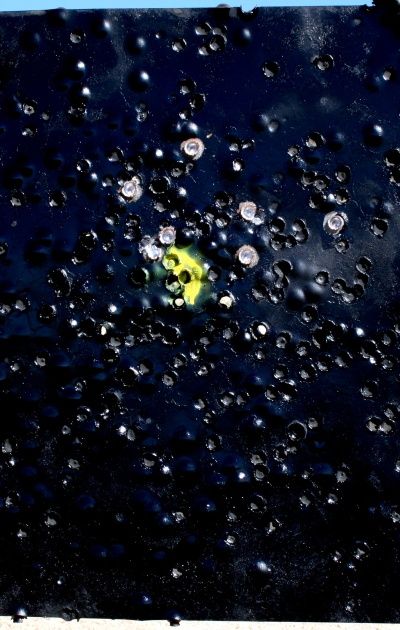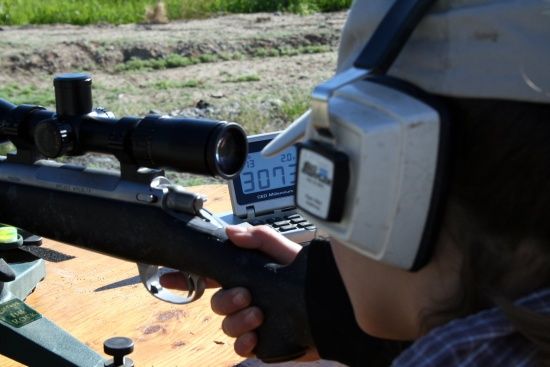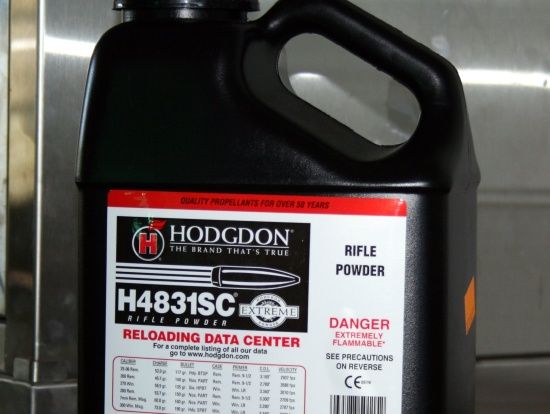In our last a segment, we discussed range-finders and high Ballistic Coefficient bullet's, and how they have extended our potential for bullet placement and performance at long range. In this article we need to examine why consistent velocities are important to precise shot placement. And more specifically, how our selection of primers and powders affect down range accuracy.
For guys shooting 400, maybe 500 yards, good groups at 100 yards can translate into decent accuracy and shot placement. When we start shooting past 500 yards on out to 1000 yards, relatively small changes in muzzle velocity from shot to shot will have a large effect on the vertical dispersion for your shot string. Meaning that your shots will land higher and lower than your aim point. As we start applying our long range shooting techniques to hunting situations, it is imperative that we reduce the impact of any variables that could effect the clean harvest of our game.

Target groups showing an extreme spread of 5 inches and 10 inches on an 800 yard steel target.
The whole idea behind long range shooting is precision shooting—making that one shot kill. And while we can discuss the sporting nature of a 750 yard shot, no one that really understands the capabilities of today's technology can argue the ethics of taking a shot at that range when a shooter has really put in the time in preparation. Not when there are so many hunters out there that routinely shoot beyond their capabilities—even if its only 100 yards! The ethical consideration is more about the preparation than the distance. So let's prepare by fully understanding the subtleties of our equipment.
First, let's define a few terms that we need to understand. Muzzle Velocity MV is just that, the velocity of the bullet at the muzzle of the gun (usually measured in feet per second, fps, and referenced at 15 feet from the muzzle). Extreme Spread ES is a statistical term that basically defines the difference between the highest and lowest numbers of a group. For example, 35 fps would be the extreme spread for a velocity string of 3000, 3010, 2990, and 3025. Standard Deviation SD is also used to discuss velocity variations. It implies the probability of dispersion from your aim point. For that reason, it is meaningless for hunters looking to quantify performance. Ethically we need to reduce the chance of an errant shot to zero. That's why I believe that monitoring our extreme spreads will guarantee we aren't surprised by a high or low flier.
Now, where do all these numbers come from and what effect do they have at long range? A chronograph is one of the most important tools a hunter can own. They are generally priced between $99 and $250. They are not just for reloaders either, even if you shoot factory ammo, you need to monitor your velocities. If we don't bother with SD, a chronograph will measure MV, and we can calculate ES by subtracting the smallest number in a group from the highest (3025-2990=35).

The authors daughter shooting over the chronograph.
The funny thing about ES is that you probably won't notice the effects of large ES on a 100 yard target, but the effects on an 800 yard target can be astounding. An ES of 65 fps is not uncommon in factory ammo, in fact, I have recorded ES of 150 fps in some premium ammunition costing nearly $5 per shot! For a 7mm Rem Mag and a 160 grain Nosler Partition at about 3000 fps MV, an ES of 65 fps translates to 6.5 inches of vertical dispersion on your target, and 100 fps is about 10 inches (at 1000 yards the error is almost 20”)! Its a total accident that those numbers appear to have a correlation, but it is apparent that more consistent velocities are required for longer shots.
With the same 7mm cartridge and a 168 grain VLD bullet, an ES of 30 fps will cause about 5” of vertical dispersion to your group at 1000 yards. On a long range hunting system, 30 fps should be considered a guideline maximum extreme spread.
Now that we have the preliminaries out of the way, we need to get to the information that will help us get this extreme spread under control. First, for non-loaders, you may have to test several premium types of ammunition to find the low ES that we need. For handloaders, or guys that have buddies that handload, there are several component selections that can really simplify the development of long range handloads. We will cover powder and primer selection in this article, and we will allude to brass preparation and selection as another component, but one that will require its own pages in a future article.
Selecting the right powder can be a tedious trial and error task involving multiple components and hundreds of loads, or we might luck into the right combination on our first try. There are a few qualifiers we can place on our selection of powders that can reduce the field—and our potential workload.
Temperature Stability is an often overlooked phenomena that can have a significant effect on muzzle velocity. Select a powder that is known for its consistency in temperature extremes. We want to have the same velocity and point of impact on our targets whether we are hunting couse deer in 90 degree Arizona or mule deer in 0 degree Wyoming. Hodgdon advertises its extreme line of powders, and the general consensus is they do work as advertised. Just because a certain powder isn't listed as an extreme powder doesn't indicate that it won't behave properly, it just means that you need to test it.

Hodgdon's Extreme line of powders is very temperature stable.
One of the most striking examples I have measured was a very good shooting load in a .243 Winchester. We had 42.5 grains of Brand X powder with the 95 grain Nosler Ballistic Tip shooting about 5/8” groups. The velocity averaged 3025 fps on the fall day I developed the load. I shot that load for several years at targets and game animals at ranges out to 500 yards without any problems. When we really started the long range shooting at targets out to 1000 yards and beyond, I reevaluated my favorite .243 load, and decided that I needed a higher Ballistic Coefficient, and testing in the middle of summer showed an average velocity of 3085 fps from the same lot of powder. That's 60 fps for about a 50 degree temperature rise. The effects of temperature sensitivity can cause a miss at long range, and unsafe pressures.
It is simple to test, take five loads in a cooler out to the range on a hot summer day and record the average velocity of five hot shots and five cold ones. That will give you an indication of how that powder behaves at different temperatures. Other temperature factors that could effect velocity include bore dimension changes, and primer effectiveness for extreme cold weather. It is important to shoot and practice with our long range gear in these type of conditions to really understand our equipment and prepare for those important shots.
Once we have narrowed our powder to a few choices, we need to look at the potential of our selections to create a load that has a low extreme spread (remember we are looking for less than 30 fps). We are generally running slower powders in our long range cartridges, and one characteristic that I have noticed about one of our favorite powders (Hodgdons Retumbo) is that consistent burn rates, and the resulting velocity spreads seem to be very dependant on the chamber pressures (see Table 1). Specifically, clean burning and consistent velocities and the resulting low extreme spreads for this powder requires loads that approach or are at the SAMMI maximums. Running less than full house loads almost guarantees poor accuracy and erratic velocities. Other powders may behave the same or they may like lower pressures. The main thing is don't give up on a great powder just because your starting loads don't show promise.

While we are on the subject of maximum loads, I would like to point out that the only way we can get close to measuring or evaluating the pressure of a cartridge is to monitor the velocity with a good chronograph. Different chambers and bore dimensions will have different pressures—and rifles are just not the same! Just dumping in the maximum powder charge listed in a load manual might be ok, or the pressure might be too low or too high. Looking at cases and primers is not adequate, and neither is monitoring bolt stiffness or other subjective indicators.
If the load manual suggests 3000 fps velocity for a certain powder, that should be considered a maximum velocity. Use data from multiple manuals to get an average maximum velocity for that cartridge and powder and load to that velocity. I have often found that the maximum loads listed give velocities hundreds of feet per second slower in my guns. By loading to the velocity, I was able to achieve a reasonable velocity without running high pressures. The bottom line is that pressure and velocity are related, and by measuring one, we can monitor the other.
Before we wrap up this article, I would like to briefly cover two other components of the long range accuracy equation. Primer selection can have a significant effect on the velocity and the extreme spread of your load. Always reduce your powder charges when changing primers, then increment back to your maximum velocity. Table 2 shows the difference in velocity and extreme spreads for a sample powder charge in the 7mm Rem Mag with 168 Berger VLD bullet's. The worst thing about primers is there is no indicator for the best choice other than trial and error. The wrong primer can make the right powder look bad, be careful when drawing conclusions.

Another step in preparing for load development is brass preparation. There are enough factors in this topic to require a separate article, but to sum up, look at two factors specifically, case capacity and neck tension. Weight sorting cases is simple, and while I might think it is silly for practice rounds, it has legitimate merit for load development or hunting rounds. A general rule of thumb for a large rifle case is +/-7 grains of brass weight means more or less case capacity equating to nearly 1 grain of powder. I have measured over 5 grains of weight difference in one bag of Winchester brass in 7mm Rem Mag. Changing a load by one grain of powder can cause a difference in velocity of 50 fps. That is well outside of our 30 fps minimum extreme spread criteria for long range precision shooting.
Check the neck tension by examining dimensions of the neck diameter after sizing, and after seating your bullet you should have at least 0.001” but no more than 0.002” difference. You may have to change bushings or polish an expander ball to get there. Some shooting experts recommend lubricating the inside of the neck. It is a theory worthy of experimentation.
We can cover more about brass preparation in a future article, the reason we covered some of the subject here is to realize that there are other factors that can effect your extreme spreads that have nothing to do with powder type or charge. Once you have the right rangefinder and drop compensating scope and your ready to start shooting distances that are “Beyond Belief”, be careful that you are fully prepared for that once in a lifetime opportunity.
Powders, Primers, and Long Range Shooting